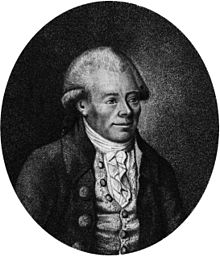Georg Christoph Lichtenberg
| Georg Christoph Lichtenberg | |
|---|---|

Georg Christoph Lichtenberg
|
|
| Born |
1 July 1742 Ober-Ramstadt near Darmstadt, Hesse-Darmstadt |
| Died | 24 February 1799 (aged 56) Göttingen |
| Nationality | German |
| Fields | Scientist, satirist and aphorist |
| Alma mater |
University of Göttingen (1763–67) |
| Doctoral advisor | Abraham Gotthelf Kästner |
| Doctoral students |
Heinrich Wilhelm Brandes Johann Tobias Mayer |
Georg Christoph Lichtenberg (1 July 1742 – 24 February 1799) was a German scientist, satirist, and Anglophile. As a scientist, he was the first to hold a professorship explicitly dedicated to experimental physics in Germany. Today, he is remembered for his posthumously published notebooks, which he himself called Sudelbücher, a description modelled on the English bookkeeping term "scrapbooks", and for his discovery of the strange tree-like electrical discharge patterns now called Lichtenberg figures.
Lichtenberg was the youngest of 17 children of pastor Johann Conrad Lichtenberg. His father, ascending through the ranks of the church hierarchy, eventually became superintendent for Darmstadt. Unusually for a clergyman in those times, he seems to have possessed a fair amount of scientific knowledge. Georg Christoph Lichtenberg was educated at his parents' house until 10 years old, when he joined the Lateinschule in Darmstadt. His intelligence and wit became obvious at a very early age. He wanted to study mathematics, but his family could not afford to pay for lessons. In 1762, his mother applied to Ludwig VIII, Landgrave of Hesse-Darmstadt, who granted sufficient funds. In 1763, Lichtenberg entered the University of Göttingen, where in 1769 he became extraordinary professor of physics, and six years later ordinary professor. He held this post till his death.
Lichtenberg became a hunchback owing to a malformation of his spine. This left him unusually short, even by 18th-century standards. Over time, this malformation grew worse, ultimately affecting his breathing.
...
Wikipedia
